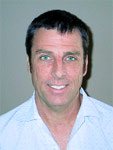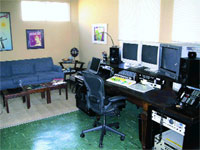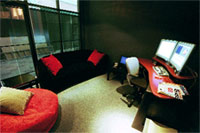
Kim Tierney Production Manager Video Post & Transfer, Dallas www.videopost.com
|
POST: Do you think the democratization of the post industry due to lower-cost, professional-quality equipment (e.g., Apple Final Cut Pro, Adobe After Effects) is helping or hurting the industry? Why?
DOMINIC PANDOLFINO: "The 'democratization' of the post industry is changing the industry in irreversible ways, sometimes for better and sometimes for worse. Change, like most things in life, has a double edge. For example, the fact that equipment is more affordable allows more people to be a part of the creative process, employing those people who otherwise might be excluded from the equation. This could have the effect of increasing overall productivity while allowing people who are working on low-budget jobs to be able to complete their projects.

Randy Magalski Senior Editor The Post Group, Los Angeles www.postgroup.com
|
"Where it may hurt the industry is that there will be many people who claim to be something they are not: every college kid looking for a job can now claim to be an editor. Additionally, many small, new boutiques are typically not equipped with the proper gear to always do what is necessary for the client. Furthermore, they don't always have the experience or expertise to do the job without creating a problem for the client. Established houses that expand into this [low-cost tools] arena may have an advantage because clients will be familiar with their work ethic and know what to expect."
KRISTIN O'CONNOR: "It's absolutely helping the industry. Today the business is more about creativity than conformity. It's about placing a higher value on the creative and having a critical mass of creative individuals rather than being a big organization with a lot of overhead. This model adds more stylistic flexibility to the marketplace."
RANDY MAGALSKI: "I wholeheartedly say it's helping the industry. When you have more players in the game, it's inevitable that you have more ideas and more innovation. The downside is that people don't have the big picture; they may have no idea how what they do will impact others further down the pipeline. But not knowing the rules sometimes is great. People who are more entrenched in the industry, and with the way things have always been done, don't tend to break the rules. But people outside the circle have always had different ways of approaching things."

Bill Fortney Executive Producer Avenue, Santa Monica www.avenue-edit.com
|
BILL FORTNEY: "All in all, it's helping the industry. I know it's a concern when anyone can get access to really professional-quality equipment, but since we primarily represent creative editorial talent it's not an issue, as long as we have the best people managing projects. Lower-cost technology allows us to integrate some things to serve clients better and permits younger creative people to show what they can do sooner than they might have in the past. Barriers to entry used to be financial; now it's about talent and experience."
KIM TIERNEY: "It's actually expanding the industry by giving a chance to people who never thought they could get into the business because of the high price of technology. Is it taking work away from us? People who are buying Final Cut for their laptops probably weren't going to come here for Fire and Inferno sessions. But they're contacting us about providing other services for them like audio sweetening. These are people who never would have called us before."
POST: What has been your company's response to this trend?

Kristin O'Connor President Greybox, Richmond, VA www.greybox.cc
|
O'CONNOR: "Greybox exists because of this trend. We have uncompressed Avid and Final Cut Pro suites and After Effects. Our senior editor and producer Scott Witthaus knows Avid and everything that goes into managing an edit really well while editor Devin Bousquet grew up on Final Cut. So we built our business model around both of them and really rockin' customer service. Some younger clients gravitate to Final Cut and others stay with Avid because Final Cut is still a new thing. We made a safe decision and an investment in the future by offering both platforms. Greybox just opened last year and we were extremely successful. It was interesting to see that our Final Cut/After Effects and uncompressed Avid Xpress Meridien rooms had equal billings."
PANDOLFINO: "It's ultimately being welcomed in Nice Shoes and Guava. Our foundation is talent, experience, a conducive environment for creativity and the ability to deliver on time. Often, with lower-end equipment, the issue is throughput. We are looking forward to including that technology when needed or required and making those tools available to our own talent pool. We presently employ After Effects in all our graphics and editing rooms and have a sister company, Freestyle Collective, a design and branding company that works almost exclusively at this level. They are extremely talented and add a dimension to Guava and Nice Shoes that otherwise wouldn't exist. So we're able to integrate what Freestyle Collective does with Nice Shoes and Guava for greater flexibility and attention to cost."

Dominic Pandolfino Managing Partner Nice Shoes, New York City www.niceshoes.com
|
TIERNEY: "We've embraced it. In addition to our Adrenaline suite and three Fire rooms - two with Inferno - we have a graphics room with Final Cut Pro and After Effects. We cut directors reels on Final Cut with After Effects or Photoshop animations on the front end. We can do quick turnaround, internal corporate projects with Final Cut for less than what we'd charge in another edit suite. Final Cut and After Effects have become universal tools. Our assistants know Final Cut and everyone seems to have After Effects knowledge."
FORTNEY: "We have After Effects and use it often, and we also have Fire. We can composite in Fire and do work in After Effects instead of in another Fire, which allows us to be more efficient. We don't have Final Cut yet but we probably will at some point. We haven't had a call for it, but it's low cost enough so why not get it? You can go out to a set with Final Cut, most kids coming out of school are cutting on it, and I understand that Apple requires its vendors to cut its spots on Final Cut. HD may be another driving factor for Final Cut."
MAGALSKI: "In most industries the initial reaction by established players to something new is to say part of their revenue stream is being threatened. But when the tidal wave is inevitable, you have to figure how to swim with it. Democratization breaks into two camps: producers without extremely tight deadlines who can pursue lower-cost solutions and producers with tight deadlines who have to bite the bullet and spend what it takes to finish fast. Flying 27 different layers in compositing may take three days to render on After Effects but if you have the incredible horsepower of Inferno on SGI behind you, it may take three hours to render the same sequence.

Avenue's offline bay has Discreet Fire and Adobe After Effects, and Bill Fortney says they're looking into Final Cut Pro, too.
|
"We have Final Cut at The Post Group, but we primarily use it for machine deck control for I/O. Offlining and uprezing within Final Cut are great but EDLs from Final Cut consistently require more massaging so we prefer offlining on Avid and finishing on Symphony. We also have After Effects, but our Inferno, Fire, Combustion, DS|Nitris and Flame are faster and better tools with a high-end talent pool. With its low price and accessibility, I'd put Combustion in the category of democratic tools. It has worked extremely well augmenting our higher-priced Discreet systems, performing mundane tasks like rotoscoping and tracking while an Inferno artist concentrates on the more creative aspects of the job."
POST: Is the democratization of post the business model of the future?
MAGALSKI: "As more and more clients do more work themselves or via cheaper alternatives, it will be our challenge to figure out how to fit in the new paradigm. Where we fit best is in our ability to meet accelerated deadlines with hardware and software options that give clients peace of mind. We also have the breadth of experience to steer clients in new creative directions and to offer alternatives for saving time and money. And with 24p HD becoming the only accepted deliverable, the traditional post house and its technological expertise will become valuable in a way mom-and-pop shops cannot."
PANDOLFINO: "Since we feel that democratization is an irreversible trend, it will certainly become a greater part of our business model for the future. I don't see a limit to where the technology will go, but it will certainly continue on its present trend with greater speed. Well-rounded facilities of the future will be a healthy combination of high- and lower-end equipment."

Greybox's Final Cut Pro suite. Company president Kristin O'Connor believes democratization is "absolutely helping the industry."
|
FORTNEY: "Democratization is a good thing, but at the end of the day business is all about servicing clients and having the right approach to creative problem solving. Having more cost-effective tools at your disposal is good, but I don't think it really changes the dynamic of the client-post house relationship. It just allows more flexibility. Will people who open new Final Cut shops be a threat to Avenue? It will give more people an opportunity to show what they can do, but only a few will be able to bring what's needed creatively to a project. Additionally, the average agency and client aren't served well by a one-person shop: they need the systems and support structure of a larger company."
O'CONNOR: "It marks an important change in the industry emphasizing talent, hard work, the spirit of thrift and efficiency over [the big] organization."
TIERNEY: "There will always be clients who want to go to higher-end facilities with experienced artists and the capability of handling film and HD. HD still represents quite an investment with monitors, decks and technical know-how. It's not a mom-and-pop platform. But it would behoove most facilities to embrace the lower-cost professional tools so they can service a new market."